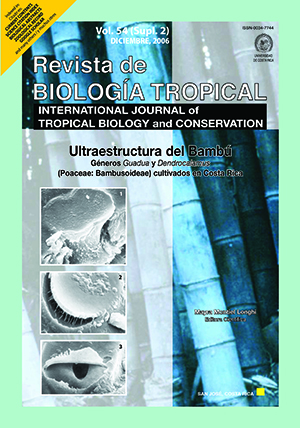Abstract
Dendrocalamus giganteus is one of the biggest, strongest and most used bamboos. An ultrastructural analysis of samples from a Costa Rican population showed that there are three forms of cuticular wax accumulations, shaped like ceric papillae. In the abaxial zone of the leaf lamina there are square structures composed by two silica cells in the boundaries and double ceric papillae in the lateral parts; in the center there are spherical papillae. These structures are unique for this species. Rev. Biol. Trop. 54(Suppl. 2): 59-63. Epub 2006 Dec. 01.References
Bisen, S.S. 1999. Identification and classification of Indian Bamboos (SEM Atlas of epidermis). Bishen Singh Mahendra Pal Singh, Dehra Dum, India. 200 p.
Dransfield, S. & E.A Widjaja. 1995. Plant Resources of South-East Asia Nº 7. Bamboos. Backhuys, Leiden, Los Paises Bajos. 189 p.
Ghosh, S.S. & B.S. Negi. 1959. Anatomical features of bamboo used for paper manufacture. Symposium on Cellulose Research. CSIR. Nueva Deli, India, p. 139-148.
Kozuka, Y. & M. Montiel. 1990. Ultrastructure of Bamboo fibers, a comparative study on four Bamboo species from Costa Rica. Bamboo J. Jap. Soc. Bamboo Dev. Protec. 8: 84-91.
Liese, W. 1995. Anatomy and utilization of Bamboos. Eur. Bamboo Soc. J.: 4-12.
Lin, W.C. 1981. Subfamily Bambusoideae, p. 706-783. In Flora of Taiwan. Vol. 5. Reprinted Epoch, Taipei, Taiwán.
Metcalfe, C.R. 1960. Anatomy of the monocotyledons. I. Gramineae. Oxford Clarendon, Oxford, Inglaterra. 731 p.
##plugins.facebook.comentarios##

This work is licensed under a Creative Commons Attribution 4.0 International License.
Copyright (c) 2006 Revista de Biología Tropical






